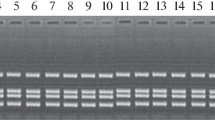Summary
Four strains of rhizobia that nodulate canavanine-synthesizing legumes and four strains that nodulate noncanavanine-synthesizing legumes were tested for sensitivity to L-canavanine. The effect of canavanine on growth depends upon the strain of Rhizobium tested rather than the canavanine synthesizing capability of the host legume. In both groups of rhizobia, some strains were inhibited in growth by canavanine. Canavanine enhancement of growth was observed in rhizobia that nodulate noncanavanine-synthesizing legumes.
Canavanine was found to enhance incorporation of uridine-H3 and L-leucine-H3 into trichloroacetic acid insoluble fractions of starved cells of two strains of rhizobia tested. This demonstrated that under certain conditions some rhizobia can detoxify canavanine and utilize it in synthetic processes. re]19760729
Similar content being viewed by others
References
Birdsong, B. A., Alston, R. and Turner, B. L., Distribution of canavanine in the family Leguminosae as related to phyletic groupings. Can. J. Bot. 38, 499–505 (1960).
Fowden, L., Lewis, D. and Tristram, H., Toxic amino acids: Their action as antimetabolites. Adv. Enzymol. Relat. Areas Mol. Biol. 29, 89–163 (1967).
Grenson, M. and Hennaut, C., Mutations affecting activity of several distinct amino acid transport systems inSaccharomyces cerevisiae. J. Bacteriol. 105, 477–482 (1970).
Hare, J. D., Reversible inhibition of DNA synthesis by the arginine analogue canavanine in hamster and mouse cellsin vitro. Exp. Cell Res. 58, 170–174 (1969).
Kalyankar, G. D., Ikawa, M., and Snell, E. E., The enzymatic cleavage of canavanine to homoserine and hydroxyguanidine. J. Biol. Chem. 233, 1175–1178 (1958).
Konobu, K., Antagonism between arginine and canavanine on adaptive formation of formic hydrogenlyase inEscherichia coli No. 1. Yakuguka Zasshi 83, 33–36 (1963).
Kruse, P. F., White, P. B., Carter, H. A. and McCoy, T. A., Incorporation of canavanine into protein of Walker carcinosarcoma 256 cells culturesin vitro. Cancer Res. 19, 122–125 (1959).
Lockhart, W. R. and Garner, H. R., Genetic mechanisms governing the effect of canavanine onNeurospora crassa. Genetics 40, 721–725 (1955).
Phillips, D. A. and Torrey, J. G., Cytokinin production byRhizobium japonicum. Physiol. Plant. 23, 1057–1063 (1970).
Rosenthal, G. A., Investigations of canavanine biochemistry in the jack bean plant,Canavalia ensiformis (L.) DC. I. Canavanine utilization in the developing plant. Plant Physiol. 46, 273–276 (1970).
Rosenthal, G. A., Investigations of canavanine biochemistry in the jack bean plant,Canavalia ensiformis (L.) DC. II. Canavanine biosynthesis in the developing plant. Plant Physiol. 50, 328–331 (1972).
Rosenthal, G. A., Gulati, D. K. and Sabharwal, P. S., Studies on the growth effects of the canaline-urea cycle amino acids withLemna minor L. Plant Physiol. 56, 420–424 (1975).
Simonnet, G. M. and Chapeville, F., Action de la canavanine sur la synthese du RNA chezE. coli. Eur. J. Biochem. 9, 199–206 (1969).
Sköld, O. and Zetterberg, A., Studies on the amino acid regulation of RNA synthesis in mammalian cells in tissue culture. Exp. Cell Res. 55, 289–294 (1969).
Stent, G. and Brenner, S., A genetic locus for the regulation of RNA synthesis. Proc. Nat. Acad. Sci. U.S.A. 47, 2005–2014 (1961).
Teas, H. H., Effect of canavanine on mutants ofNeurospora andBacillus subtilis. J. Biol. Chem. 190, 368–375 (1951).
Turner, B. L. and Harborne, J. B., Distribution of canavanine in the plant kingdom. Phytochem. 6, 863–866 (1967).
Valera, C. L. and Alexander, M., Nodulation factor forRhizobium-legume symbiosis. J. Bacteriol. 89, 1134–1139 (1965).
Weaks, T. E., Effects of canavanine on arginine utilization in plants with special reference to mitotic activity. Physiol. Plant. 31, 144–148 (1974).
Weaks, T. E. and Hunt, G. E., The effects of canavanine on protein and nucleic acid synthesis in canavanine resistant and sensitive species of higher plants. Physiol. Plant. 29, 421–424 (1973).
Weaks, T. E. and Hunt, G. E., The effects of canavanine on the growth of isolated roots of four plant species. Bot. Gaz. 135, 18–21 (1974).
Williams, S. E. and Hunt, G. E., Canavanine distribution in jackbean fruit during fruit growth. Planta 77, 192–202 (1967).
Author information
Authors and Affiliations
Rights and permissions
About this article
Cite this article
Weaks, T.E. Differences between strains of rhizobium in sensitivity to canavanine. Plant Soil 48, 387–395 (1977). https://doi.org/10.1007/BF02187248
Received:
Issue Date:
DOI: https://doi.org/10.1007/BF02187248




